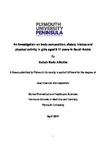An investigation on body composition, dietary intakes and physical activity in girls aged 8-11 years in Saudi Arabia
| dc.contributor.supervisor | Rees, Gail | |
| dc.contributor.author | Alkutbe, Rabab Bade | |
| dc.contributor.other | Faculty of Health | en_US |
| dc.date.accessioned | 2018-01-18T13:05:20Z | |
| dc.date.available | 2018-01-18T13:05:20Z | |
| dc.date.issued | 2017 | |
| dc.identifier | 10374953 | en_US |
| dc.identifier.uri | http://hdl.handle.net/10026.1/10607 | |
| dc.description.abstract |
Introduction: Obesity has become a major world-wide health issue. Social-economic status, physical activity levels and dietary intake may influence the weight status in children. However, these issues have not been examined together in studies of young girls in Saudi Arabia. Aim: This study aimed to investigate energy and nutrient intakes, physical activity and social economic status of girls aged 8-11 years in western Saudi Arabia according to their BMI. Methods: This study was conducted in two phases, phase one was a pilot study where 32 girls were selected to assess the suitability of body composition, dietary intake (food diary, food frequency questionnaire) and physical activity measurement tools (pedometer, physical activity questionnaire). The findings of this phase were employed in phase 2; the diet diary and accelerometer were nominated as assessment tools. In phase two, girls (n= 234) participated from different schools. Waist circumference, height and weight were measured and BMI was calculated. Girls were classified according to BMI centile charts (CDC). Dietary intake was measured via a 4-day food diary and accelerometers were used to assess the intensity and time spent in physical activity. Results: A total of 30% of the sample were classified obese or overweight. There was a significant difference in the mean daily energy intake between the BMI groups with the obese group having the highest energy, fat, carbohydrate and protein intake (obese group: 2677 ± 804 kcal/d; healthy weight group: 1806 ± 403 kcal/d, p< 0.001), but the percentage contribution of the macronutrients to energy intake remained the same across the BMI groups. Carbohydrate intake was shown to be the main contributor to predict obesity levels. VI There were no differences in number of steps taken per day or time spent in moderate/ vigorous intensity exercise according to BMI category. Most of the girls did not meet daily physical activity guidelines (5969 to 6773 steps per day and 18.5 - 22.5 mins per day of moderate- vigorous activity). Intake of sweets and sugary drinks, and total energy intake were significantly higher in the high income group compared to the low income group. However, family income was not associated with BMI status. Conclusion: The results of this study suggest that obesity in girls aged 8-11 years is linked to excessive energy intake from all macronutrients and the majority of girls in all weight categories are inactive. Research should be conducted to develop interventions to promote dietary change and activity that is culturally acceptable for girls in Saudi Arabia. | en_US |
| dc.language.iso | en | |
| dc.publisher | University of Plymouth | |
| dc.subject | Energy intake | |
| dc.subject | Girls | |
| dc.subject | Nutrient intake | |
| dc.subject | Physical activity | |
| dc.subject | Obesity | |
| dc.subject | Energy balance | |
| dc.subject | Body fat | |
| dc.subject | Dietary habits | en_US |
| dc.subject | BMI | en_US |
| dc.subject.classification | PhD | en_US |
| dc.title | An investigation on body composition, dietary intakes and physical activity in girls aged 8-11 years in Saudi Arabia | en_US |
| dc.type | Thesis | |
| plymouth.version | publishable | en_US |
| dc.identifier.doi | http://dx.doi.org/10.24382/1149 | |
| dc.rights.embargoperiod | No embargo | en_US |
| dc.type.qualification | Doctorate | en_US |
| rioxxterms.version | NA |
Files in this item
This item appears in the following Collection(s)
-
01 Research Theses Main Collection
Research Theses Main


